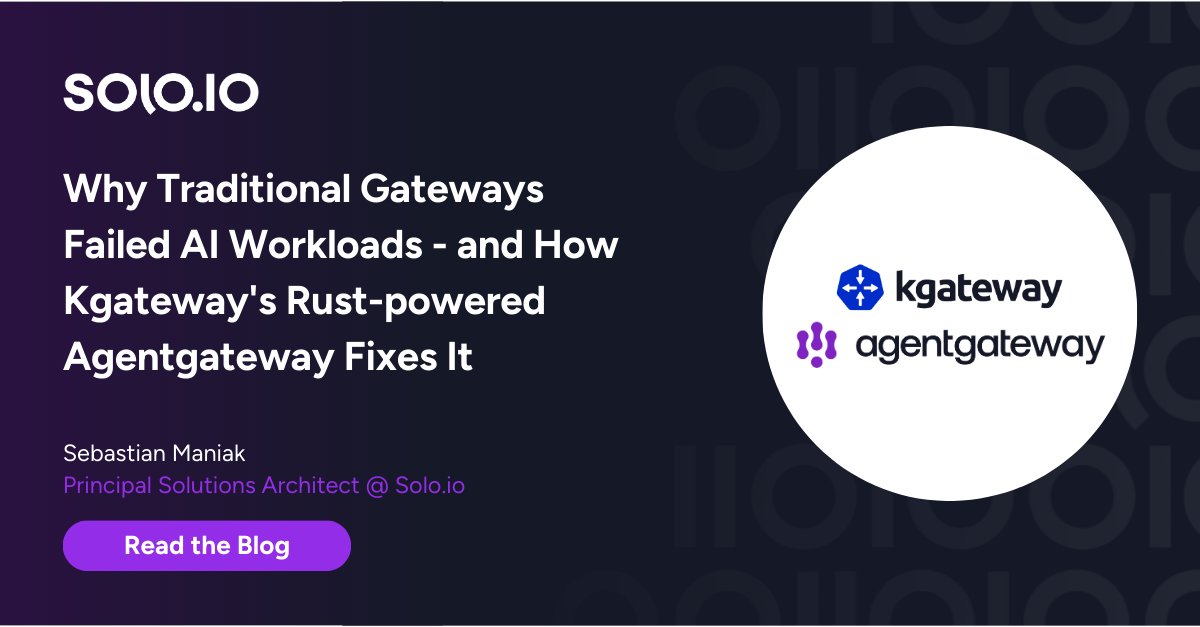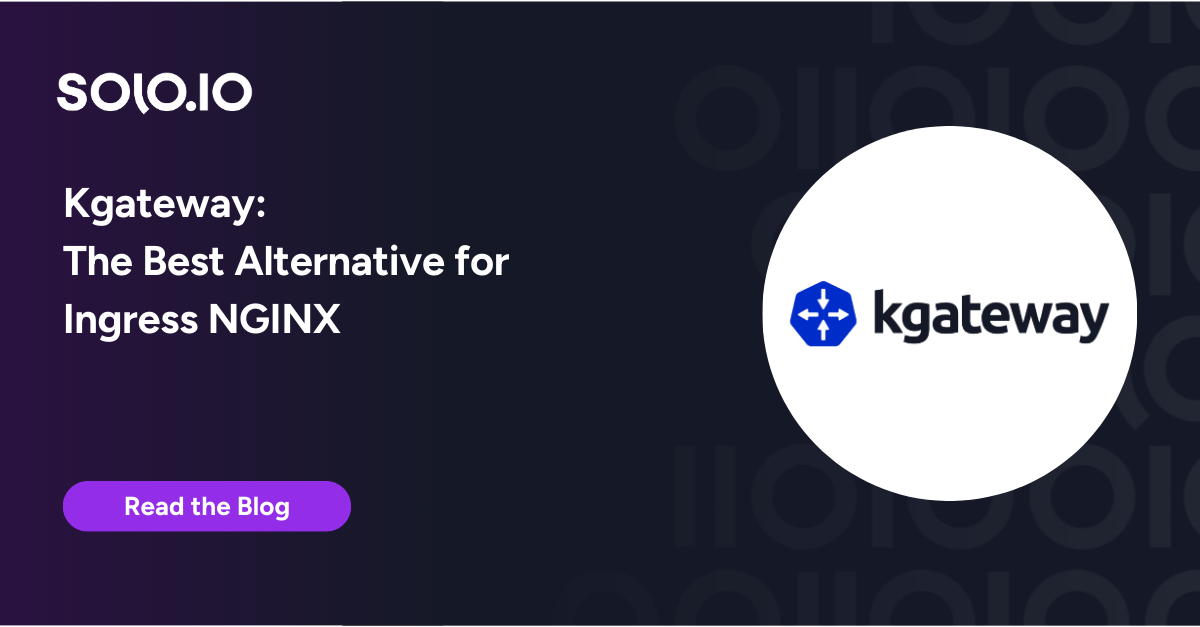What is the API gateway pattern?
The API gateway pattern is a common architectural pattern in which an API gateway sits between the client and a collection of microservices. The API gateway acts as a single entry point for clients to access the microservices, allowing clients to interact with the microservices as if they were a single service.
The API gateway can perform tasks such as authentication, rate limiting, and caching to improve the performance and security of the microservices. This pattern is often used in microservice-based architectures to help manage and route requests to the various microservices.
The evolution of API gateways and Solo Gloo Gateway
Several factors are reshaping how users evaluate API gateways:
- How well does it scale to handle a larger volume of API traffic?
- How well does it perform at a larger scale?
- How well does it consistently deliver low-latency response times?
- Does it natively work in public cloud or any Kubernetes environments?
- Does it leverage the latest innovations in proxy technologies (e.g. Envoy Proxy)?
- Does it leverage the latest open source innovations around proxy technologies (e.g. WebAssembly or GraphQL)?
As each of these issues become more impactful to how an API gateway can enable your microservice applications, the more companies are beginning to choose Solo.io Gloo Gateway. Based on Envoy Proxy, Gloo Gateway enables greater scalability and latency than legacy API gateways based on NGINX, HAProxy, or Java-wrappers on proxy technology.
In addition, Gloo Gateway is both public cloud native and Kubernetes native, so integrating with DevOps environments is seamless. And Gloo Gateway enables users to easily add new innovations such as Web Assembly or GraphQL to their API Gateway environment to handle next-generation application needs.
Get started with Gloo Gateway today!
When to use the API gateway pattern
There are several situations in which the API gateway pattern can be useful:
- When you have a microservice architecture: If you have a system that is built using microservices, an API gateway can be used to route requests from clients to the appropriate backend service and then return the service’s response back to the client.
- When you need to expose your backend services to external clients: An API gateway can be used to expose your backend services to external clients over the internet, while still keeping the backend services protected and secure.
- When you need to add additional functionality: An API gateway can provide additional functionality, such as request routing, load balancing, caching, and authentication, which can be useful if you want to add these capabilities to your system.
- When you need to hide the complexity of your backend services: An API gateway can hide the complexity of the backend services from the client, making the client’s code simpler and easier to maintain.
Common API gateway design patterns
1. Centralized edge gateway
A centralized edge gateway is an API gateway design pattern in which all incoming requests are routed through a single API gateway, which sits at the edge of the system and routes requests to the appropriate backend service. This pattern is simple to implement and can provide a single entry point for all requests, making it easy to add security and other functionality.
In a centralized edge gateway pattern, the API gateway sits between the clients and the backend services and acts as a reverse proxy, routing requests from clients to the appropriate backend service and then returning the service’s response back to the client. The API gateway can also provide additional functionality, such as request routing, load balancing, caching, and authentication.
One advantage of the centralized edge gateway pattern is that it provides a single, stable interface for clients to access the backend services, which can be beneficial for maintaining and scaling the system. It can also provide additional security by acting as a firewall, blocking malicious requests and only allowing requests that meet certain criteria.
2. Two-tier gateway
A two-tier gateway is an API gateway design pattern in which a client-facing gateway sits at the edge of the system and routes requests to a second gateway, which is responsible for routing requests to the appropriate backend service. This pattern can be useful if you want to separate the client-facing gateway from the backend gateway for security or scalability reasons.
In a two-tier gateway pattern, the client-facing gateway sits between the clients and the backend gateway and acts as a reverse proxy, routing requests from clients to the backend gateway. The backend gateway, in turn, routes requests to the appropriate backend service and returns the service’s response back to the client-facing gateway, which then returns the response to the client.
One advantage of the two-tier gateway pattern is that it allows you to separate the client-facing gateway from the backend gateway, which can be beneficial for security or scalability reasons. For example, you could use a different type of gateway or a different set of hardware for the client-facing gateway than you use for the backend gateway, depending on your needs.
3. Microgateway
A microgateway is an API gateway design pattern in which each microservice has its own dedicated API gateway, which routes requests to the appropriate service. This pattern can be useful if you want to give each service more control over its own traffic, but it can also be more complex to manage.
In a microgateway pattern, each microservice has its own dedicated API gateway, which sits between the clients and the service and acts as a reverse proxy, routing requests from clients to the appropriate service and returning the service’s response back to the client.
One advantage of the microgateway pattern is that it allows each service to have its own dedicated gateway, which can be beneficial for security or scalability reasons. For example, you could use a different type of gateway or a different set of hardware for each service, depending on your needs.
However, the microgateway pattern can also be more complex to manage than other patterns, as you will need to maintain and manage a separate gateway for each service.
4. Per-pod gateways
Per-pod gateways is an API gateway design pattern in which each pod (a group of one or more containers) has its own dedicated API gateway, which routes requests to the appropriate service. This pattern can be useful if you want to give each pod more control over its own traffic, but it can also be more complex to manage.
In a per-pod gateway pattern, each pod has its own dedicated API gateway, which sits between the clients and the service and acts as a reverse proxy, routing requests from clients to the appropriate service and returning the service’s response back to the client.
One advantage of the per-pod gateway pattern is that it allows each pod to have its own dedicated gateway, which can be beneficial for security or scalability reasons. For example, you could use a different type of gateway or a different set of hardware for each pod, depending on your needs.
However, the per-pod gateway pattern can also be more complex to manage than other patterns, as you will need to maintain and manage a separate gateway for each pod.
5. Sidecar gateways and service mesh
Sidecar gateways and service mesh are both API gateway design patterns that involve using a sidecar gateway to proxy incoming requests to a service.
In a sidecar gateway pattern, a sidecar gateway is deployed alongside each service, acting as a proxy for incoming requests. This pattern can be useful if you want to give each service more control over its own traffic, but it can also be more complex to manage.
In a service mesh pattern, a mesh of interconnected microservices is created, with each service communicating with the others through a central control plane. A service mesh can provide additional functionality, such as load balancing, service discovery, and monitoring, but it can also be more complex to set up and manage.
Best practices for implementing the API gateway pattern
There are several best practices that are commonly followed when implementing the API gateway pattern:
- Keep the API gateway lightweight and focused on routing and managing requests. Avoid adding business logic to the gateway, as this can make it difficult to maintain and scale.
- Use the API gateway to perform tasks such as authentication, rate limiting, and caching to improve the performance and security of the microservices.
- Use a decentralized approach to routing, where each microservice is responsible for its own routing. This allows each microservice to evolve and scale independently.
- Use a declarative routing approach, where the routes are defined in a configuration file rather than hard-coded in the gateway. This makes it easier to manage and update the routes as the microservices evolve.
- Use a circuit breaker pattern to prevent cascading failures in the microservices. This allows the API gateway to automatically failover to a backup service if a microservice becomes unavailable.
- Monitor the performance of the API gateway and the microservices to identify potential issues and areas for improvement. Use this information to fine-tune the configuration of the gateway and the microservices to improve their performance and reliability.


























%20a%20Bad%20Idea.png)











%20For%20More%20Dependable%20Humans.png)











